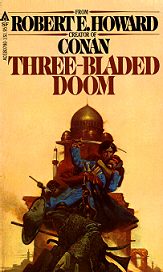 Three-Bladed
Doom (El Borak)
Three-Bladed
Doom (El Borak)
Copyright1977, by Glenn Lord
First Ace printing: December 1979
(out of 5)
****
Francis Xavier Gordon, also known as El Borak ("The Swift"), was obviously modeled after Lawrence of Arabia, and was virtually identical to Howard's other eastern adventurer, Kirby O'Donnell. Starting with G.A. Henty around the turn of the century, an entire sub-genre of adventure fiction developed, set in India and Afghanistan, involving fierce hill tribes, Russian Cossacks and British (or, in El Borak's case, American) heroes fighting to protect India from invasion by way of the Khyber Pass. Nowadays, most of us wouldn't know a Ghilzai from an Afridi, but, in those times, Afghanistan was big news. Much like the American western, this "Oriental" sub-genre had its own fully-developed set of conventions which sprang from the prejudices of the time. Thus, the hill tribes are always savage, hot-blooded, but fiercely honourable, while Sikhs are more civilized, stoic, and unmatched fighters. As a result, the peripheral characters in Howard's El Borak stories are more vividly drawn than in many of his other stories -- provided we can forget he was basing those characteristics on racial stereotypes.
Only five El Borak stories were published during Robert E. Howard's lifetime. Another story was later discovered and published under the title "The Lost Valley of Iskander". Similarly, "Three-Bladed Doom" was found after Howard's death, having initially been written in 1934 as a 42,000 word novella, then shortened the next year to 24,000 words. Neither version sold, which is odd because it's a pretty good story. Still, of the El Borak tales, this is probably a little weaker than most.
"Three-Bladed Doom" was published for the first time by Zebra Books in 1977. The other El Borak tales appeared in Son of the White Wolf and The Lost Valley of Iskander.
"Three-Bladed Doom" is the lengthiest El Borak story, but still not really novel length, even though Ace published it as such. (This is the longer 42,000 word version.) It begins with the attempted assassination of the Amir of Afghanistan, the most recent in a string of assassinations of eastern rulers friendly to the British. The assassins belong to a cult whose symbol is a three-bladed dagger. Investigating, El Borak is attacked and his Sikh friend, Lal Singh, is kidnapped. El Borak traces the assassins to the mysterious city of Shalizahr, where a medieval cult has been recreated, the ancient "Assassins". Here, men from all over the east are drugged with hashish, placed in a beautiful garden with gorgeous women and told it is paradise. Then they are told they must faithfully carry out assassinations if they wish to "regain paradise". Naturally, the show is being run by a Russian Cossack bent on overthrowing British rule. El Borak runs into a female friend, Azizun, petted daughter of a Delhi moslem, forced to act as one of the gorgeous women in the gardens. With her help, he rescues Lal Singh and, with the further aid of an army of Ghilzais, puts paid to the nefarious scheme.
As I've said elsewhere, the El Borak yarns are my favourites, second only to the Conan stories. Extremely sure-footed, they are very tightly written, a perfect balance between description and fast-paced action. Also, the characterization is more subtle than in most of Howard's work. "Three-Bladed Doom" is no exception.
One small weakness, however, is that Azizun could have been handled better. On the one hand, the addition of a female character (rare in an El Borak story) is a welcome plus, raising the story above some of the others. On the other, Azizun isn't nearly as interesting as Yasmeena from "The Daughter of Erlik Khan". We simply don't see enough of her, nor do we ever find out what she thinks of all this. Though she is present in most scenes, we don't really feel her presence -- if you know what I mean.
The final act is also less than might be hoped for. The intrigue and one-on-one adventures of the earlier parts are replaced with the sort of massed battle scenes which Howard obviously loved so much, but which come across as impersonal and confusing. The ending just seems to go on too long, and I can't help but suspect that may explain why it was never published.
Balancing these negatives is the chapter, "haunter of the gulches" -- an evil djinni lurks beyond a strange doorway, dispatching victims tossed to it. This is the only time a supernatural element crops up in an El Borak story, and, for me, it makes for the best part of the tale.
Finally, the title itself takes third prize after the Conan titles, The Hour of the Dragon and "The Slithering Shadow".
L. Sprague de Camp rewrote "Three-Bladed Doom" as the Conan pastiche, "The Flame Knife", in which he added some ghouls. Grrrr.

Visit ![]() Pulp and Dagger Webzine ("Where
the Heroes are!")
Pulp and Dagger Webzine ("Where
the Heroes are!")